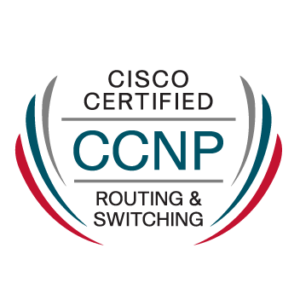
Overview
Cisco Certified Network Professional (CCNP) Routing and Switch certification validates the ability to set up, implement, test, and troubleshoot local and wide area enterprise networks. The program covers the implementation of secure IPv6 enabled local area network and WAN routing solutions to support today’s business critical services, as well as the widespread adoption of BYOD throughout the Enterprise. It also covers high availability, switch virtualization, and climbable VPN technologies, which are required to support branch offices and modify mobile men.
CCNP The abilities required in enterprise roles such as network engineer, support engineer, systems engineer, or network technician are indisputable when it comes to routing and switching. This certification’s routing and switch protocol data can provide a solid foundation because these skills are applicable in both physical networks today and virtualized network functions in the future.
The CCNP Routing and Switching certification is appropriate for you if you have at least one year of networking experience and are able to advance your skills and work on advanced network solutions on a regular basis.
The exam also covers the setup of highly secure routing solutions to support branch offices and mobile employees. The following topics are general pointers for the content that will almost certainly be included on the test. However, different related topics may appear on any given version of the test. The following pointers may change at any time quickly to better replicate the contents of the test and for clarity.
You’ll learn how to maintain and monitor network performance, as well as troubleshoot Multi-Protocol system networks, in this course. In addition, our Cisco Certified instructors will show you how to:
- Build a scalable routed network using appropriate technologies.
- Create campus networks by utilizing multilayer switching technologies.
- Enhance the traffic flow, reliability, redundancy, and performance of campus LANs, routed and switched WANs, and remote access networks.
- Create and implement a global intranet.
- Troubleshoot a multiprotocol client host and service environment that makes use of Cisco routers and switches.
The Cisco Certified Network Professional CCNP Training Routing and Switching certification verifies the ability to develop, implement, verify, and debug local and wide-area enterprise networks, as well as collaborate with experts on sophisticated security, voice, wireless, and video solutions.
The CCNP Routing and Switching certification is designed for those with at least one year of networking experience who are eager to enhance their abilities and work independently on complicated network solutions.
Those who have earned the CCNP Routing and Switching certification have proved the abilities required for positions in the enterprise such as network engineer, support engineer, systems engineer, or network technician.
This certification’s routing and switching protocol expertise will provide a solid foundation because these skills are equally applicable in today’s physical networks and tomorrow’s virtualized network services.
- Training from the greatest security experts or experienced educators.
- The interactive and lab-intensive training environment provides professionals with in-depth information.
- Professionals can validate their potential as security system experts.
- Learning from experienced and thought-leadership specialists.
You will become an expert in the following areas:
- EIGRP based solutions
- Multi-area OSPF Networks
- eBGP based solutions
- IPv6 based solutions
- IPv4 or IPv6 based redistribution solutions
- Layer 3 Path Control Solutions
- VLAN based solutions
- Security Extensions of Layer 2 solutions
- Switch based Layer 3 services
- High Availability
You will take the following exams as part of your CCNP training:
- 300-115 SWITCH Cisco IP Switched Networks Implementation (SWITCH)
- 300-101 ROUTE Cisco IP Routing Implementation (ROUTE)
- Troubleshooting and Maintaining Cisco IP Networks 300-135 TSHOOT (TSHOOT)
You must have a valid Cisco CCNA (Routing & Switching) certification or any Cisco CCIE certification before enrolling in this course.
Participate in CCNP Routing and Switching Training
This CCNP R&S course is designed for network technicians who have 3 to 5 years of experience with routing and switching.
Network directors who are new or aspiring to be directors. There is normally a cost when a fresher IT professional begins a professional-level course, but the CCNP dives immediately into advanced routing, switching, and troubleshooting topics. Networking professionals advance through the Cisco certification programme from entry-level technician (CCENT) to Associate level (CCNA) to skilled (CCNP) and finally professional (CCNP) (CCIE). Before going into the complex topics covered in the CCNP Routing and Switching, new network technicians should begin with CCENT or CCNA level training.
Technicians with network experience. CCNP Routing and Switching training is intended for experienced network technicians with at least 5 years of experience operating complex Cisco network solutions. The coaching teaches students to become CCNP R&S certified and puts them for the next career step to Cisco Certified Internetwork Professional (CCIE).
EXAM FORMAT
For the Cisco CCNP and CCDP certifications, Implementing Cisco Informatics Switched Networks (SWITCH 300-115) might be a 120-minute qualifying exam with 30 – 40 questions. The SWITCH 300-115 test validates winning candidates’ switch knowledge and skills. They are accredited in the design, configuration, and validation of complex enterprise switch solutions based on the Cisco Enterprise field design.
Exam Name | CCNP Routing and Switch |
Exam Number | 300 -115 SWITCH |
Exam Duration | 120 Minutes |
Exam Cost | $300 USD |
Exam Format | Multiple Choice |
Total Questions | 30 – 40 |
Passing Score | Variable (750-850 / 1000 Approx.) |
Testing Center | Pearson VUE |
Language | English |
COURSE OUTLINE
The following subjects are general recommendations for the information that will almost certainly be included on the exam. However, alternative related topics may also appear on any particular delivery of the exam. The rules below may change at any time in order to better replicate the substance of the exam and for clarification purposes.
1.1 Set up and test switch administration, Layer 2 protocols, VLANs, Ether Channels, spanning trees, and other LAN switching technologies.
1.2 Explain chassis virtualization and aggregation technology.
2.1 Set up and test the switch’s security features
2.2 Explain device security with Cisco IOS AAA, TACACS+, and RADIUS.
3.1 Set up and test first-hop redundancy protocols
Choose Your Preferred Learning Mode

1-TO-1 TRAINING
Customized schedule Learn at your dedicated hour Instant clarification of doubt Guaranteed to run
ONLINE TRAINING
Flexibility, Convenience & Time Saving More Effective Learning Cost Savings


CORPORATE TRAINING
Anytime – Across The Globe Hire A Trainer At Your Own Pace Customized Corporate Training
Get In TOUCH
Frequently Asked Questions

Routing is the process through which things are sent starting with one space and progressing to the next. Cisco switches handle routing and capacity exchange. Draw a picture of what each capability will do.
Routing is a method of conveying and maintaining awareness of the system topology. Each switch maintains a steering table while driving to the destination. Layer three location to bring the packet one bit closer to its destination.
- A routing protocol is the set of rules utilized by a router or switch when it is tested with nearby switches.
- Routing protocols adjust certain bundles from various members in order to learn and maintain a steering table.
A CCNP works on Cisco networks to debug, implement, or verify systems. A CCNP may specialize in areas such as wireless or security, for example. Those having CCNP certification can work in a variety of positions ranging from IT management to network engineer.
- Cisco offers two certifications: CCNA and CCNP.
- Before you may apply for CCNP, you must first get CCNA.
- CCNA qualified employees can deal with routers and switched networks on a smaller scale, but CCNP certified personnel can do so on a much bigger scale.
